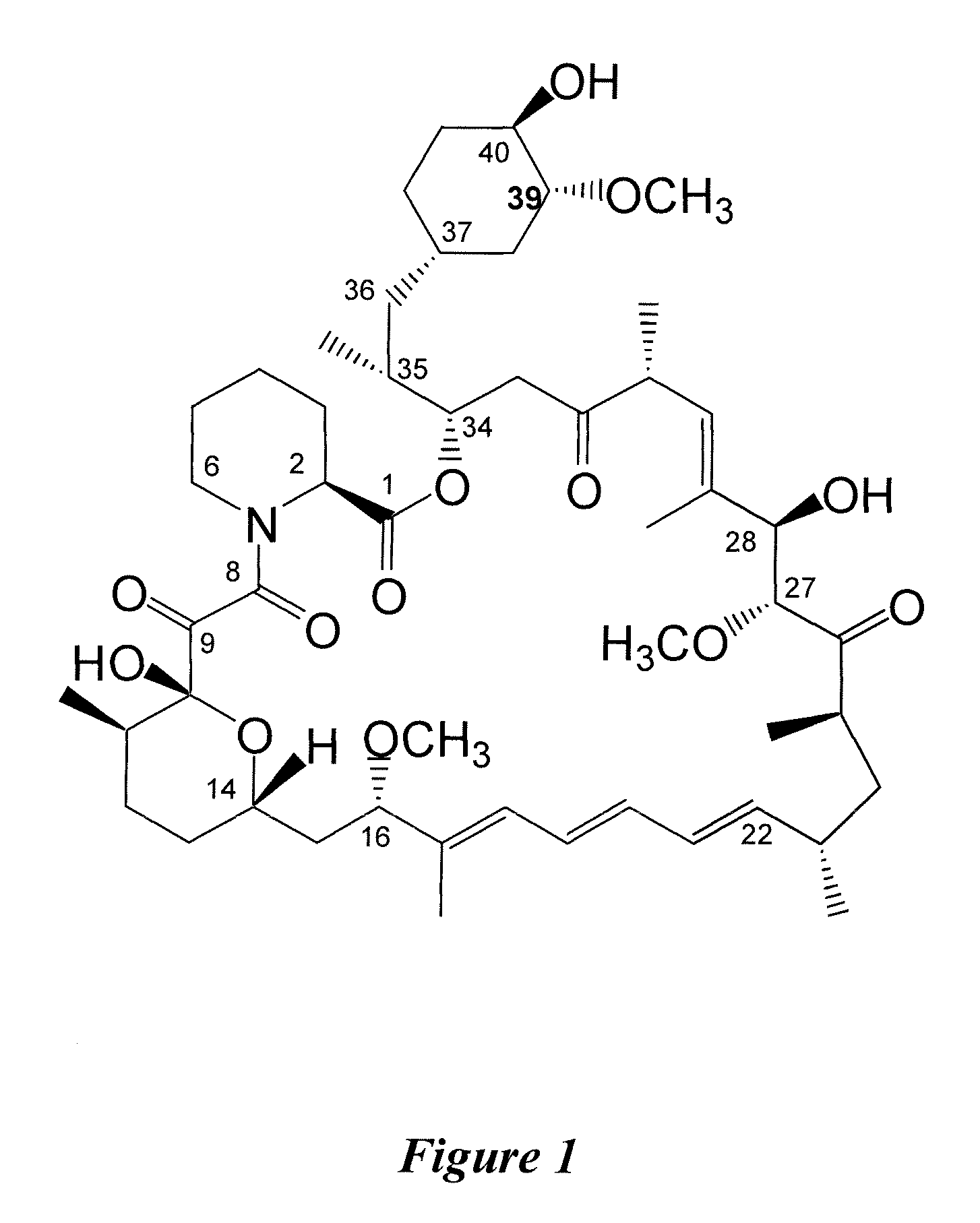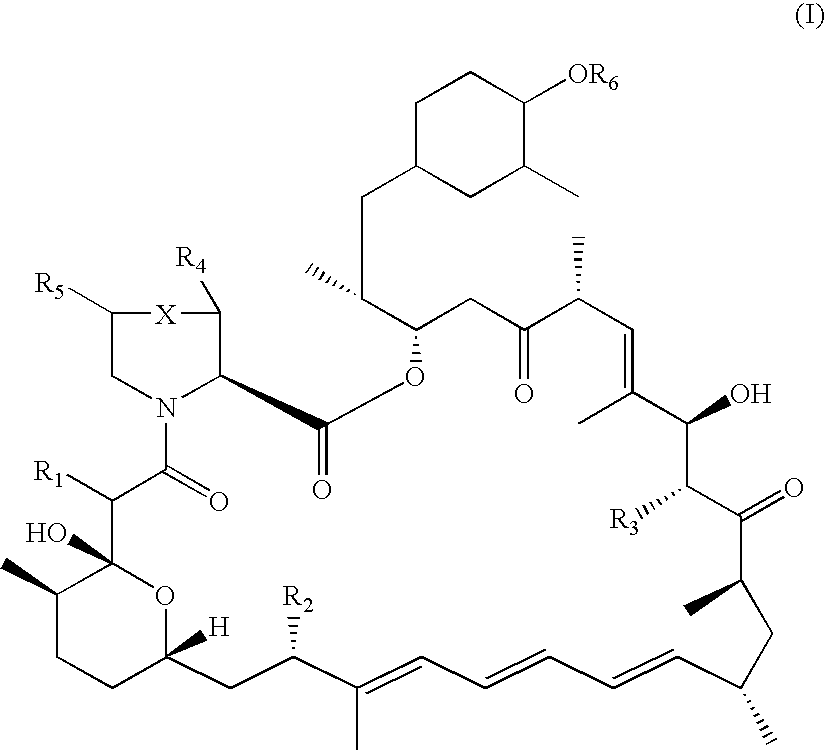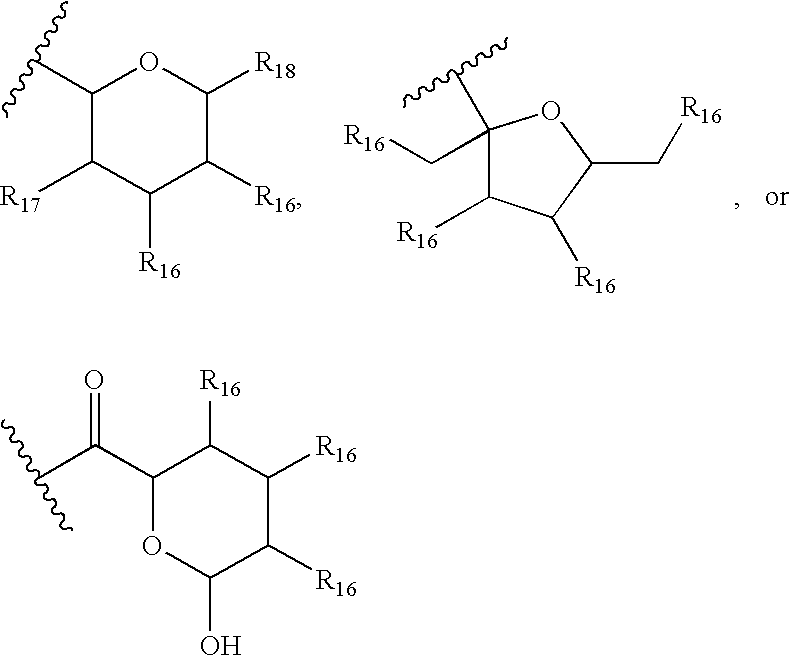39-desmethoxy-39-methyl derivatives of rapamycin
a technology of rapamycin and desmethoxy, which is applied in the direction of drug compositions, metabolism disorders, and immune system dysfunction of the host, and can solve the problems of inability to achieve sterilization through filtration, and high risk of infection and bleeding of the hos
- Summary
- Abstract
- Description
- Claims
- Application Information
AI Technical Summary
Benefits of technology
Problems solved by technology
Method used
Image
Examples
example 1
Fermentation and Isolation of 39-desmethoxy-39-methylrapamycin
[0194]39-desmethoxy-39-methylrapamycin was produced according to the methods described in WO 04 / 007709. Briefly, cultures of S. hygroscopicus MG2-10 were transformed with an appropriate expression vector carrying the rapamycin genes rapJ, rapM rapN, rapO, rapQ and rapL to produce strain S. hygroscopicus MG2-10[rapJMNOQLhis]. Cultures of S. hygroscopicus MG2-10[rapJMNOQLhis] were grown and fed with 3-methylcyclohexanecarboxylic acid using the methods described in WO 04 / 007709. LCMS and LCMSn analysis of culture extracts showed that the m / z ratio for the rapamycin analogue produced was 16 atomic mass units lower than that for rapamycin, and was consistent with the exchange of a methoxy group for a methyl group at C-39.
example 2
Synthesis of 39-desmethoxy-39-methyl-40-O-[2,2-bis(hydroxymethyl)propionyl]rapamycin Through Lipase Catalysed Esterification of 39-desmethoxy-39-methylrapamycin
[0195]A mixture of 39-desmethoxy-39-methylrapamycin, vinyl 2,2,5-trimethyl[1.3-dioxane]-5-carboxylate, lipase PS-C “Amano” II and molecular sieves (0.5 nm) in anhydrous tert-Butyl methyl ether is heated to 43° C. under an atmosphere of argon. After 48 h LC / MS monitoring shows conversion of the starting material. THF is added and the mixture is filtered through a pad of celite. The enzyme is washed twice with THF and the combined organic extracts are concentrated under reduced pressure. The residue is dissolved in THF and H2SO4 (0.5 N) is added. The solution is allowed to stand at room temperature for 5 h after which the reaction is subsequently quenched by the addition of NaHCO3 (5%) and brine. The aqueous mixture is extracted three times with ethyl acetate and the combined organic extracts are dried over MgSO4. Removal of so...
example 3
39-desmethoxy-39-methyl-40-O-(2-hydroxy)ethyl Rapamycin
3.1. 2-(tert-butyldimethylsilyl)oxyethyl Triflate
[0196]A solution of 2-(tert-butyldimethylsilyl)-ethylene glycol (125 mg, 0.71 mmol) and 2,6-lutidene (0.08 mL, 0.69 mmol) in 6 mL dichloromethane was cooled to −78° C. Trifluoromethanesulfonic anhydride (0.11 mL, 0.65 mmol) was added over a period of 5 min and stirring was continued for additional 15 min at −78° C. to complete the formation of the triflate. The triflate was used in situ for the reaction as described in 3.2 below.
3.2. 40-O-[2-(tert-butyldimethylsilyl)]ethyl-39-desmethoxy-39-Methylrapamycin
[0197]39-Desmethoxy-39-methylrapamycin and 2,6-di-tert-butylpyridine are treated with 2-(tert-butyldimethylsilyl)oxyethyl triflate at room temperature. This solution is then concentrated to a third of its original volume with a gentle stream of nitrogen and the resulting suspension is stirred for further 72 h at room temperature. After that period saturated sodium hydrogen carbona...
PUM
| Property | Measurement | Unit |
|---|---|---|
| pH | aaaaa | aaaaa |
| pH | aaaaa | aaaaa |
| atomic mass | aaaaa | aaaaa |
Abstract
Description
Claims
Application Information
 Login to View More
Login to View More - R&D
- Intellectual Property
- Life Sciences
- Materials
- Tech Scout
- Unparalleled Data Quality
- Higher Quality Content
- 60% Fewer Hallucinations
Browse by: Latest US Patents, China's latest patents, Technical Efficacy Thesaurus, Application Domain, Technology Topic, Popular Technical Reports.
© 2025 PatSnap. All rights reserved.Legal|Privacy policy|Modern Slavery Act Transparency Statement|Sitemap|About US| Contact US: help@patsnap.com



